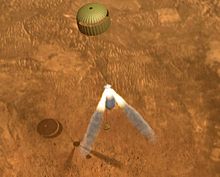Retrorocket
This article has multiple issues. Please help improve it or discuss these issues on the talk page. (Learn how and when to remove these template messages)
|


A retrorocket (short for retrograde rocket) is a
History
Rockets were fitted to the nose of some models of the DFS 230, a World War II German Military glider.[1] This enabled the aircraft to land in more confined areas than would otherwise be possible during an airborne assault.
Another World War II development was the British Hajile project, initiated by the British Admiralty's Directorate of Miscellaneous Weapons Development. Originally a request from the British Army as a method to drop heavy equipment or vehicles from aircraft flying at high speeds and altitudes, the project turned out to be a disaster and was largely forgotten after the war. Although some of the tests turned out to be successful, Hajile was too unpredictable to be used in conventional warfare, and by the time the war drew to a close, with no chance to put the project into action, it was shelved. Later Soviet experiments used this technique, braking large air-dropped cargos after a parachute descent.
Uses
Deorbit maneuvers
When a spacecraft in
Project Mercury
Due to the high reliability demanded by de-orbiting retrorockets,
Project Gemini
Gemini used four rockets, each 2,500 pounds-force (11 kN), burning for 5.5 seconds in sequence, with a slight overlap. These were mounted in the retrograde section of the adapter module, located just behind the capsule's heat shield.[3][4]
Apollo program
For lunar flights, the
Space Shuttle program
The
Launch vehicle staging
To ensure clean separation and prevent contact,
Landers
Retrorockets are also used in landing spacecraft on other astronomical bodies, such as the
Reusable launch systems
New uses for retro-thrust rockets emerged since 2010 for
New Shepard is a reusable single-stage suborbital rocket where the booster uses its main engine to land again after a flight. The capsule slows its descent with parachutes and uses retrorockets to slow down just before reaching the ground.
Operation Credible Sport
References
- ISBN 1-58663-762-2.
- ^ "Mercury capsule description & specifications". weebau.com. Retrieved 8 January 2020.
- ^ "Gemini". braeunig.us. Retrieved 7 January 2019.
- ^ "Gemini 2, 3, 4, 5, 6, 7, 8, 9, 10, 11, 12". skyrocket.de. Retrieved 7 January 2019.
- ^ "RETALT project". retalt.eu. Retrieved 8 January 2020.
- . Retrieved 8 January 2020.
- ^ Ian, D'Costa. "The US Military Planned on Using This Crazy Modified C-130 to Rescue Hostages in Iran". tacairnet.com. Retrieved 8 January 2020.
